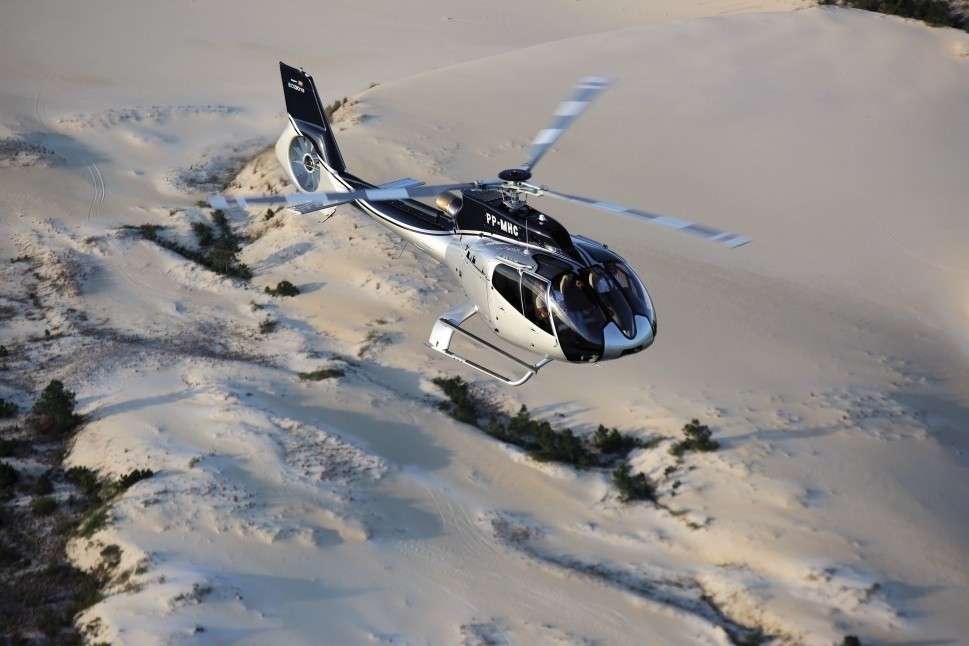- 01 Aug 2019
- Mike Chase
- Helicopter Comparisons
Helicopter Comparison: Airbus H130 v Bell 206L-4
How will the Airbus H130 compare against the Bell 206L-4? What are the strong points for each helicopter, and which would suit your mission need the best? Mike Chase compares these two popular single engine turbines side-by-side...
Back to Articles
In this month’s Helicopter Comparison, Mike Chase provides information on a pair of popular single-engine turbine helicopters. How will the Airbus H130 compare with the Bell 206L-4? What are the pros and cons of each? Find out here…
Over the following paragraphs, we’ll analyse the performance of the Airbus H130 helicopter and Textron’s Bell 206L-4 helicopter to see how they compare within the market. We’ll consider productivity parameters (payload, range, speed and cabin size) and discuss their current market values, among other things.
Having begun operations in 2012, the Airbus H130 is still in production. The Bell 206L-4 was built from 1992, but production ceased in 2017.
Airbus H130
The Airbus H130 (formerly the Eurocopter EC130 T2) replaced the EC130B-4 Ecureuil. It features a more powerful Arriel 2D engine and a re-designed gearbox resulting in increased speed and longer range than its predecessor. A new avionics suite, a crashworthy fuel system and an active anti-vibration system (improving comfort for passengers) was also incorporated.
At the time of writing there were 264 Airbus H130 helicopters in operation worldwide. With four aircraft still at the manufacturer and a further six retired, a total 274 units of this helicopter type have been built. Almost all the H130s in operation around the world are wholly owned (261), and just three are in shared ownership.
North America is home to the largest Airbus H130 fleet percentage (44%), followed by Europe (18%) and Asia (18%). Together, these regions account for a combined 80% of the fleet.
Payload & Range
The data contained in Table A represents information about aircraft payload and range, and is sourced from both OEMs, JETNET and B&CA magazine. As we have mentioned previously, potential operators should focus on payload capability as a key factor in selecting the right aircraft for the mission need.
TABLE A: Airbus H130 vs Bell 206L-4 Payload & Comparison
Cabin Cross-Section Comparison
According to Conklin & de Decker, the Airbus H130 cabin volume measures 65cu.ft compared with the Bell 206L-4’s 73cu.ft. Chart A, courtesy of UPCAST JETBOOK, represents a cabin cross-section comparison and shows the Airbus H130 cabin has more width (6.12ft vs 3.9 ft) but the same height (4.2 ft) when compared with the Bell 206L-4. Not depicted is the fact that the Airbus H130 is also longer compared to the Bell 206L-4 (7.19 ft versus 5 ft) – though pilot space is not included in this measurement.
CHART A: Airbus H130 vs Bell 206L-4 Cabin Comparison
Conklin & de Decker explains that calculating length, width and height alone won’t work when establishing an aircraft’s cabin volume. For example, the curve of the cabin must also be accounted for (and in this case, the Airbus H130 cabin curves while the Bell 206L-4 cabin is square). Hence the Bell 206L-4 cabin volume is greater while its width and length are shorter.
The typical seating configuration for the Airbus H130 offers five executive passenger seats compared to five seats for the Bell 206L-4. The Airbus H130 provides 40cu.ft. external luggage space, while the Bell 206L- 4 offers 20cu.ft.
The Airbus H130 (327nm) and the Bell 206 L4 (325nm) have nearly identical ‘normal’ ranges, according to data taken from each OEM.
Powerplants
The Airbus H130 is powered by one Turbomeca Arriel 2D engine with 802shp transmission rating (the transmission rating is a limiting factor in the total rated and usable engine power output). Meanwhile, the Bell 206L-4 is powered by one Rolls-Royce 250-C30P turbine engine with 600shp.
Helicopter Usage Comparison
Chart B shows the usage of both helicopters. Interestingly, for both helicopters the largest percentage group of usage is ‘business’, and ‘charter’ is the next largest percentage of usage.
CHART B: Airbus H130 vs Bell 206L-4 Usage Comparison
Total Variable Cost
The ‘Total Variable Cost’, illustrated in Chart C, is defined as the Cost of Fuel Expense, Maintenance Labor Expense, Scheduled Parts Expense, Engine Overhaul, and Miscellaneous Trip Expense.
The Total Variable Cost for the Airbus H130 computes at $614/hr., which more than the Bell 206 L4 ($574/hr.), according to Conklin & de Decker.
CHART C: Airbus H130 vs Bell 206L-4 Variable Operating Cost Comparison
Helicopter Comparisons
Table B contains the used 2017 price from Vref Pricing Guide for each helicopter model. The average speed, cabin volume and range values are from the OEM/Conklin & de Decker, while the number of helicopters in-operation and percentage ‘For Sale’ are as reported by JETNET.
TABLE B: Airbus H130 vs Bell 206L-4 Market Comparison
Depreciation Schedule
Helicopters that are owned and operated by businesses are often depreciable for income tax purposes under the Modified Accelerated Cost Recovery System (MACRS). Under MACRS, taxpayers are allowed to accelerate the depreciation of assets by taking a greater percentage of the deductions during the first few years of the applicable recovery period (see Table C).
TABLE C: Part 91 & Part 135 MACRS Schedule
There are a variety of factors that taxpayers must consider in determining if a helicopter may be depreciated, and if so, the correct depreciation method and recovery period that should be utilized. For example, helicopters used in charter service (i.e. Part 135) are normally depreciated under MACRS over a seven-year recovery period or under ADS using a twelve-year recovery period.
Helicopters used for qualified business purposes, such as Part 91 business use flights, are generally depreciated under MACRS over a period of five years or by using ADS with a six-year recovery period.
There are certain uses of helicopters, such as non-business flights, that may impact on the allowable depreciation deduction that is available in a given year.
Table D represents an example of using the MACRS schedule for a 2017 model Airbus H130 helicopter in private (Part 91) and charter (Part 135) operations over five- and seven-year periods, assuming a used 2017 retail price of $2.6m (per Vref).
TABLE D: Airbus H130 MACRS Depreciation Schedule
TABLE E: Bell 206L-4 MACRS Depreciation Schedule
At the time of writing, the used helicopter market for Airbus H130s showed eight were for sale, all displaying an asking price. The price range for H130s fell between $2.38m and $3.35m. Meanwhile, there were 24 used Bell 206L-4 helicopters available for sale, 11 of which displayed an asking price. The price range for this model ranged between $772k and $1.8m.
While each serial number is unique, the airframe hours (AFTT) and age/condition will cause great variations in price. Of course, the final negotiated price remains to be decided between the seller and buyer before the sale of an aircraft can be completed.
Productivity Comparisons
The points in Chart D are centered on the same helicopters. Pricing used in the vertical axis is as published by Vref for 2017 model helicopters. The productivity index requires further discussion in that the factors used can be somewhat arbitrary. Productivity can be defined (and it is here) as the multiple of three factors:
- Normal or standard range;
- An average or standard cruise speed flown to achieve that range;
- Cabin volume available for executive passenger seating.
Others may choose different parameters, but serious helicopter buyers are usually impressed with price, range, speed and cabin size. After consideration of the price, range, speed and cabin size, we can conclude that the Airbus H130 displays a high level of productivity.
CHART D: Airbus H130 vs Bell 206L-4 Productivity Comparison
The 2017-model Airbus H130 shows a $150k higher purchase price and a higher variable hourly operating cost than the Bell 206L-4, but greater speed . However, the Bell 206L-4 offers a slightly larger cabin volume and greater ‘Payload with Full Fuel’ capability.
It's easy to see why both models remain popular on the helicopter sales market today. Operators should weigh up their mission requirements precisely when picking which option is the best for them.
Summary
Within the preceding paragraphs we have touched upon several of the attributes that helicopter operators value. However, there are other qualities that might factor in a buying decision.
Our expectations are that the Airbus H130 helicopter will continue to do well in the new/used helicopter market, and the Bell 206L-4 will continue to be an attractive option on the used helicopter market for the foreseeable future.
Related Articles
- 01 Feb 2019
- Mike Chase
- Helicopter Comparisons
- 01 Sep 2018
- Mike Chase
- Helicopter Comparisons


